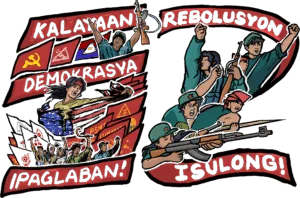2. In the Course of World War II, 1941 to 1945
Immediately following its surprise attack on Pearl Harbor in December 1941, Japan invaded the Southeast Asian countries. The communist parties of Southeast Asia exposed the phenomenon of fascism and the inter-imperialist war as the result of the rotten character and crisis of the world capitalist system, called for the national unity of all anti-fascist forces and the building of the people's armies and other revolutionary forces against Japan.
The inter-imperialist war created the excellent conditions for the communist parties and the people to build their revolutionary strength in fighting the Japanese invasion and occupation. The communist parties organized people's armies against Japan mainly among the peasant masses, engaged in land reform and built organs of political power in Indochina, Philippines, Indonesia, Malaya and Burma.
The Communist Party of Indochina had organized the Revolutionary League for the Independence of Vietnam (Viet Minh) since 1941 to unite the communist and other anti-fascist forces to engage in guerilla warfare against the Japanese invaders and occupiers. It succeeded in building a powerful people's army based in the countryside and in building organs of political power and mass organizations. Ultimately, it defeated the Japanese aggressors, launched the uprising of August 1945 to seize political power, proclaim the Democratic Republic of Vietnam and suppress the pro-Japanese collaborators and made preparations to fight the plan of the French colonialists to reconquer Vietnam in 1946 and thus to ignite the First Indochina War.
The Communist Party of Indonesia was able to build guerrilla forces during the resistance against Japan and an alliance of the left wing and youth section of the Indonesian Socialist Party. These were the most reliable forces for upholding the proclamation of national independence by Sukarno in August 1945, frustrating the British military intervention and continued use of Japanese military units and fighting the return of Dutch colonialism to Indonesia. The US also began to intervene in Indonesian affairs.
The merger party of the Communist and Socialist parties in the Philippines organized the People's Army Against Japan (Hukbalahap) in 1942, independently of the US Armed Forces in the Far East (USAFFE). Despite Right opportunist errors in strategy, it was able to build units of the people's army and organs of political power and carry out land reform. But it overconcentrated in only one region close to the national capital region and was unable to expand the revolutionary movement on a nationwide scale.
US imperialism took tremendous special efforts to reconquer the Philippines as a colony because of its strategic importance in the US counteroffensive against Japan and the US plan to impose its hegemony over the whole of Southeast Asia even at the expense of its imperialist allies. As early as September 1943 the US had started its bombing operations in the Philippines to destroy Japanese forces and to prepare for massive US troop landings in 1944.
Right opportunism persisted in undermining the merger party of the Communist and Socialist parties because of the leadership's decision to welcome the return of the US imperialist military forces and the puppet Commonwealth government. Subsequently, the Browderite line of peace and democracy blew in from the Communist Party of the USA, which had had a long relationship with the merger party.
The Malayan Communist Party built the Malayan People's Anti-Japanese Army and cooperated with British military forces in fighting against the Japanese occupation. But it maintained its initiative and independence. It demanded the independence of Malaya from British colonialism upon the defeat of Japan, thus incurring the hostility of British imperialism which was determined to recolonize Malaya and secure British interests in Southeast Asia.
The Burmese Communist Party took a major role in organizing the Anti-Fascist People's Freedom League (AFPFL) to fight the Japanese occupation which began in 1941-42. The AFPFL cooperated with the British military forces to expel the Japanese in 1945. Later on, it came under the control of military officers who increasingly became anti-communist, chauvinist and militarist. The Burmese Communist Party and the national minorities resisted the military regime.

